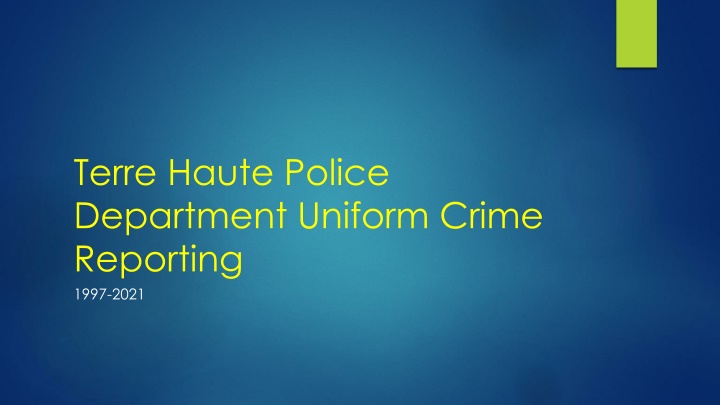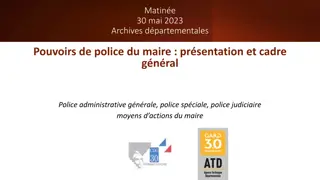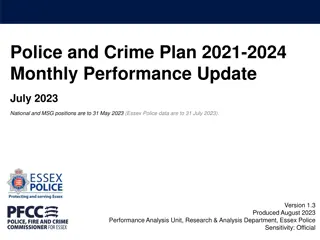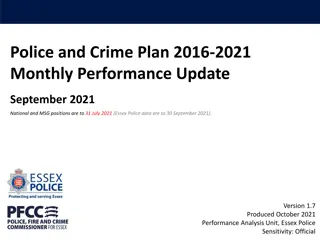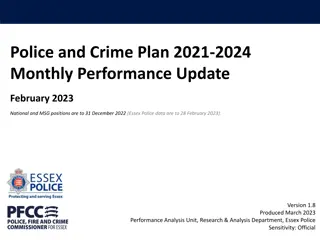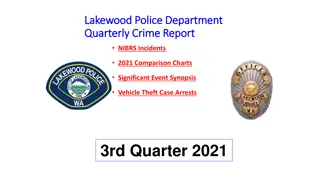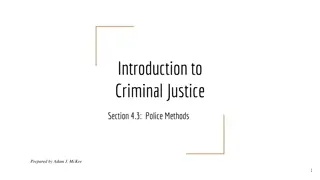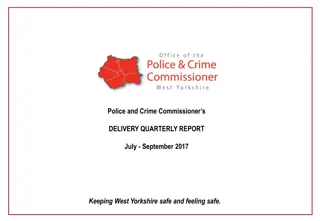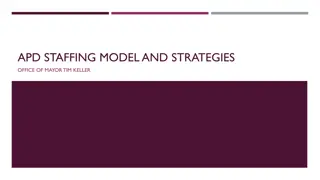Overview of Changes in Uniform Crime Reporting by Terre Haute Police Department
The Terre Haute Police Department transitioned to incident-based reporting developed by the FBI in 2018, resulting in a more detailed collection of crime data. However, coding issues arose due to incorrect classification of certain crimes, notably aggravated assaults. Collaboration with the Indiana State Police and the FBI has been ongoing to rectify these coding errors, with efforts made to ensure accurate reporting for 2021 and subsequent years.
Download Presentation

Please find below an Image/Link to download the presentation.
The content on the website is provided AS IS for your information and personal use only. It may not be sold, licensed, or shared on other websites without obtaining consent from the author.If you encounter any issues during the download, it is possible that the publisher has removed the file from their server.
You are allowed to download the files provided on this website for personal or commercial use, subject to the condition that they are used lawfully. All files are the property of their respective owners.
The content on the website is provided AS IS for your information and personal use only. It may not be sold, licensed, or shared on other websites without obtaining consent from the author.
E N D
Presentation Transcript
Terre Haute Police Department Uniform Crime Reporting 1997-2021
What is the FBI Uniform Crime Report? The FBI Uniform Crime Report has been providing crime data to law enforcement agencies and the public since 1930. Basically, it collects crime data from law enforcement agencies that voluntarily provide it for tabulation. Since each state has different statutes for crimes, the FBI creates standardized or uniform definitions for the crimes in their data reports. For example, a burglary statute in one state may include breaking into a car; however, the FBI defines burglary for tabulation as unlawful entry of a structure to commit a felony or theft. Therefore, each state must ensure their statutory definitions of crimes fit the FBI s standardized language before reporting. This is essential to ensure that the same type of crime is being reported and compared between jurisdictions.
What change occurred to cause this coding issue? In 2018, the Terre Haute Police Department began reporting in the new format developed by the FBI. Prior to this change, reporting was referred to as summary-based. While there were exceptions, summary meant that the highest crime to have occurred within an incident would be the only one counted under the hierarchy rule. That meant that if you had an armed robbery, theft, and other crimes committed during a single incident, only the highest crime would count toward the data. Under the new NIBRIS or incident-based reporting, all crimes would be counted to provide more detailed data. This also meant that there would be increases in the number of some of the crimes that were not counted before the change. The FBI provides a table on their website detailing these projections.
What change occurred that caused this coding Issue and what has been done to correct it? The most significant change for us was that the Indiana State Police became the pass through agency for submission to the FBI. This meant that the Indiana State Police were responsible for determining what Indiana statues corresponded to the definition of crimes under the FBI reporting standards for all Indiana law enforcement and their various records management systems. During the initial years of this migration, multiple statutes for misdemeanor batteries were incorrectly coded as 13A or aggravated assaults, which did not meet the FBI s requirement that an aggravated assault be an unlawful attack by one person upon another wherein the offender uses a weapon or displays it in a threatening manner, or the victim suffers obvious severe or aggravated bodily injury involving apparent broken bones, loss of teeth, possible internal injury, severe laceration, or loss of consciousness. To put this in perspective, the average number of aggravated assaults per year from 1997-2017 was 68.26, and after the migration to NIBRIS, the average number per year from 2018-2021 was 533. That amounts to a 683% increase in reported aggravated assaults. For the last two years, we have worked with both the Indiana State Police to help us correct the coding problems and the FBI to correct the 2021 numbers. At last communication, we have been informed by the FBI that this correction will refresh the data with the addition of the 2022 numbers.
How did we identify that a coding error was responsible for the sharp increase in reported violent crimes? In 2018, the Terre Haute Police Department became one of the first agencies in Indiana to change over to the NIBRIS reporting system. We believed the initial increase in reporting in 2018 and 2019 was just part of the transition. By 2020, we began discussions with the Indiana State Police after reviewing all of our crime data. As with all problem identification, we started by analyzing the data. In order to walk you through this process, we start by examining our property crimes.
Property Crimes When tabulating property crimes, the FBI includes the crimes of burglary, theft (larceny), and auto theft. When we examine our reported property crimes for the last 23 years from the FBI s Crime Data Explorer, we do not find numbers that could explain any significant increase. In fact, For the ten years from 1997 to 2008, we experienced an average of 5,080 reported property crimes per year. For the last 10 years, we have averaged 2,947 per year. That represents a 41.98% decrease in reported property crimes when comparing the two ten-year periods.
Violent Crimes Because the FBI Crime Data Explorer suggested a significant decrease in property crimes, we then turn our focus to the reported violent crimes. When tabulating violent crimes, the FBI includes the crimes of homicide, rape, robbery, and aggravated assault. When we look at these combined crimes, we do see a sharp increase in hundreds of new violent crimes beginning in 2018. This coincides with our agency s migration to the NIBRIS reporting. However, this still only tells us that we experienced an unprecedented data increase in violent crimes that does not seem possible. Utilizing the FBI Crime Data Explorer, we can further break down these violent crimes and look at them individually to provide more insight.
Violent Crimes Homicide Using the FBI s Crime Data Explorer, we look specifically at the reported homicides from 1997 to 2021. From 1997 until 2021, we averaged 2.78 homicides per year. The highest year was 2001 with 8 homicides reported. All other years fluctuated between 0 and 6 homicides per year. In 2021, we had one reported homicide. We do not find any significant variation in homicides that could explain the sharp increase in reported violent crimes seen in 2018-2021.
Violent Crimes Rape Using the FBI s Crime Data Explorer, we look specifically at the reported rapes from 1997 to 2021. From 1997 until 2021, we averaged 26.26 reported rapes per year. The highest year was 2016 with 34 and the lowest year was 2011 with 16 reported rapes. All other years ranged from 18 to 33 reported rapes. In 2021, we saw 30 reported rapes. Again, we see no significant change in reported rapes to explain the hundreds of new violent crimes in the data beginning in 2018 with the migration to NIBRIS.
Violent Crimes Robbery Using the FBI s Crime Data Explorer, we look specifically at the reported robberies from 1997 to 2021. From 1997 until 2021, we averaged 75 reported robberies per year. The highest year was 2004 with 104 and the lowest year was 2014 with 51 reported robberies. All other years ranged from 54 to 97 reported robberies. In 2021, we saw 65 reported robberies. Again, we see no significant change in reported robberies to explain the hundreds of new violent crimes being reported from this migration to NIBRIS (2018 to 2021).
Violent Crimes Aggravated Assaults After reviewing homicides, rapes, and robberies, the FBI Crime Data Explorer indicates that the average number of all three crimes reported between 1997-2017 is 104.9 per year. From 2018 thru 2021, the migration to NIBRIS, the average for all three crimes was 101.75 per year. That means that the four-years of data with extraordinary violent crime rates had an average decrease when it came to homicide, rape, and robbery. Meaning that the entire increase came from the single crime of aggravated assault. As you can see by the graph below, an unbelievable increase appears in the data beginning in 2018 thru 2021. In fact, the average number of aggravated assaults per year from 1997-2017 was 68, and after the migration to NIBRIS, the average number per year from 2018-2021 was 533. That amounts to a 683% increase in reported aggravated assaults.
Conclusions For the ten years from 1997 to 2008, we experienced an average of 5,080 reported property crimes per year. For the last 10 years, we have averaged 2,947 per year. That represents a 41.98% decrease in reported property crimes when comparing the two ten- year periods. The FBI Crime Data Explorer indicates that the average number of reported homicides, rape, and robbery reported between 1997 and 2017 is 104.9 per year. From 2018 thru 2021, the period of the migration to NIBRIS, the average for all three crimes was 101.75 per year. This indicates that the four-years of data with extraordinary violent crimes rates had an average decrease when it came to homicide, rape, and robbery. This left only aggravated assaults as the source of increase. The average number of aggravated assaults per year from 1997-2017 was 68, and after the migration to NIBRIS, the average number per year from 2018-2021 was 533. That amounts to a 683% increase in reported aggravated assaults. As this represented an improbable occurrence, it lead to the discovery of the coding errors. Upon examination of the aggravated assaults, it was discovered that hundreds of misdemeanor batteries were erroneously being coded as 13As or aggravated assaults. After receiving assistance from both the Indiana State Police and FBI, the department has been notified that the aggravated assaults from 2021 will be corrected from 718 to 223 when published with the 2022 data.
